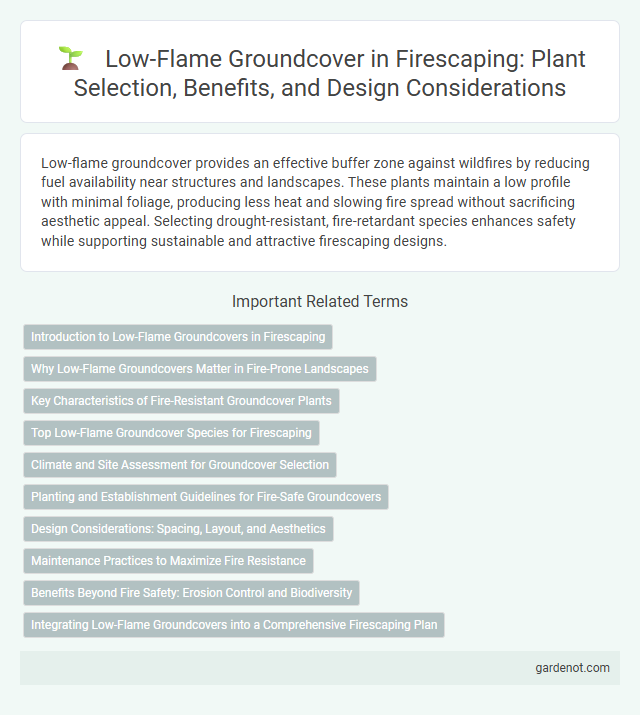Low-flame groundcover provides an effective buffer zone against wildfires by reducing fuel availability near structures and landscapes. These plants maintain a low profile with minimal foliage, producing less heat and slowing fire spread without sacrificing aesthetic appeal. Selecting drought-resistant, fire-retardant species enhances safety while supporting sustainable and attractive firescaping designs.
Introduction to Low-Flame Groundcovers in Firescaping
Low-flame groundcovers such as creeping thyme, sedum, and ice plant play a critical role in firescaping by reducing wildfire fuel near structures. These drought-tolerant plants possess low combustibility and maintain high moisture content, significantly lowering fire intensity and spread. Implementing low-flame groundcovers around homes enhances defensible space and supports fire-resistant landscaping strategies.
Why Low-Flame Groundcovers Matter in Fire-Prone Landscapes
Low-flame groundcovers are essential in fire-prone landscapes because they minimize fuel continuity and reduce fire intensity near structures. Species such as succulents, ice plants, and certain native mosses contain higher moisture content and lower flammability, effectively slowing fire spread. Incorporating low-flame groundcovers into firescaping designs enhances defensible space and improves landscape resilience against wildfires.
Key Characteristics of Fire-Resistant Groundcover Plants
Low-flame groundcover plants exhibit key characteristics such as high moisture content, low oil or resin levels, and minimal dead or dry material, significantly reducing fire spread and intensity. These plants form dense, low-growing mats that create natural firebreaks and inhibit flame propagation at ground level. Common examples include sedum, ice plant, and certain types of creeping thyme, all valued in firescaping for their fire-resistant properties.
Top Low-Flame Groundcover Species for Firescaping
Top low-flame groundcover species for firescaping include ice plant (Delosperma spp.), creeping thyme (Thymus serpyllum), and sedum varieties, all known for their low flammability and moisture retention. These species create fire-resistant buffers by maintaining high moisture content and reducing fine, dry fuels near structures. Selecting drought-tolerant, low-flame groundcovers contributes to effective defensible space and minimizes wildfire risk around homes.
Climate and Site Assessment for Groundcover Selection
Selecting low-flame groundcover requires a thorough climate and site assessment to ensure fire-resistant plant choices that thrive in the local environment. Consider factors such as seasonal rainfall, soil type, and sunlight exposure to optimize plant health and reduce fire risk. Prioritizing drought-tolerant, native species with low volatile oil content minimizes flame intensity and enhances landscape resilience in fire-prone areas.
Planting and Establishment Guidelines for Fire-Safe Groundcovers
Select low-flame groundcovers such as creeping thyme or ice plant, which possess high moisture content and minimal resin to reduce fire risk. Plant groundcovers in well-prepared, weed-free soil with adequate spacing to prevent dense fuel buildup while promoting healthy growth and rapid establishment. Maintain consistent irrigation during the establishment phase and prune regularly to remove dead material and sustain fire resistance.
Design Considerations: Spacing, Layout, and Aesthetics
Low-flame groundcover plants should be spaced at least 3 to 5 feet apart to minimize fire risk and allow for healthy growth while maintaining effective firescaping defenses. Layout design prioritizes creating natural firebreaks by grouping low-flame species near structures and using strategic placement to interrupt potential flame paths. Aesthetically, selecting drought-tolerant, low-flame groundcovers with diverse textures and colors enhances visual appeal while supporting fire-resistant landscaping goals.
Maintenance Practices to Maximize Fire Resistance
Low-flame groundcovers such as creeping thyme and sedum require regular pruning and removal of dead plant material to enhance fire resistance. Mulching with non-flammable materials reduces dryness and limits fuel accumulation around these plants. Consistent irrigation schedules maintain moisture levels, significantly lowering the risk of ignition during wildfire events.
Benefits Beyond Fire Safety: Erosion Control and Biodiversity
Low-flame groundcover offers significant erosion control by stabilizing soil with its dense root systems, reducing runoff and sediment loss on slopes and open areas. This type of vegetation promotes biodiversity by providing habitat and food sources for various pollinators and beneficial insects, enhancing ecosystem resilience. Its dual role in fire safety and environmental health makes low-flame groundcover an essential component of sustainable firescaping strategies.
Integrating Low-Flame Groundcovers into a Comprehensive Firescaping Plan
Low-flame groundcovers, such as sedum and creeping thyme, serve as effective fire-resistant barriers by reducing combustible material near structures. Integrating these plants into a comprehensive firescaping plan helps create defensible space, minimizing wildfire risk through slower flame spread and lower fuel loads. Strategic placement around foundations, pathways, and under decks enhances landscape safety while maintaining aesthetic appeal.
Low-flame groundcover Infographic

 gardenot.com
gardenot.com